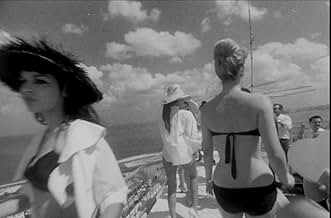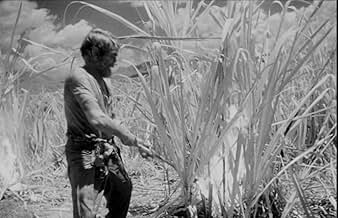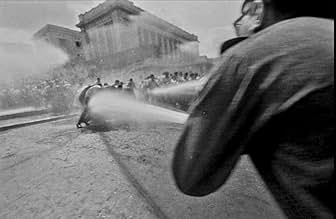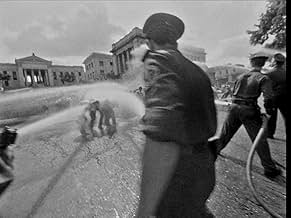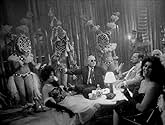Soy Cuba
- 1964
- Tous publics
- 2h 21min
NOTE IMDb
8,2/10
11 k
MA NOTE
Quatre vignettes sur la vie du peuple cubain pendant l'époque pré-révolutionnaire.Quatre vignettes sur la vie du peuple cubain pendant l'époque pré-révolutionnaire.Quatre vignettes sur la vie du peuple cubain pendant l'époque pré-révolutionnaire.
- Récompenses
- 2 victoires et 1 nomination au total
Mario González Broche
- Pablo
- (as Mario González)
Histoire
Le saviez-vous
- AnecdotesThe now famous long take that begins at the top of the hotel, then winds around and down into the swimming pool, originally come out of the water and continued. The camera was hand held, passed from crew member to crew member, to make its way down the side of the hotel into the pool. The camera lens had been equipped with a high speed, spinning glass disk taken from a submarine periscope. The spinning disk was installed to fling water drops off of the lens when the camera emerged from the swimming pool at the end of the shot. Much to the disappointment of the camera crew, director Mikhail Kalatozov cut the end of the take, ending it underwater.
- GaffesWhen Enrique gets to the top of the high-rise building he gains access to the roof by stepping through a window with a broken pane of glass. When he returns, the pane in same window is unbroken.
- ConnexionsFeatured in Soy Cuba, O Mamute Siberiano (2004)
- Bandes originalesLoco amor
(Spanish-speaking adaptation of the 1958 song "Crazy Love")
Music and lyrics by Paul Anka
Performed by El Duo Los Diablos (as Los Diablos Demonicos)
Added accompaniment music recorded later at the Prado 210 studio
With Chucho Valdés (piano), Guillermo Barreto (drums) and Orlando "Cachaito" Lopez (bass).
Commentaire à la une
Is this the best film ever made? For me today in its afterglow it is.
I'm so fickle. I think if all else were equal, I'll always take embodied, real cinema that is coherently integrated. The way of telling the story is ideally complex and folded, using tricks to make the story matter. But if the storytelling is less spectacular, as long as the thing engages, that's what matters. If it changes me, its art and important, regardless of whether I can tell a good story about the storytelling.
That's the way I prefer. But sometimes the storytelling is so spectacular, so engaging in itself, that it doesn't matter what the story is. These are rare, because after all, you need the touch to change your life. So a filmmaker as unsophisticated and unattractive as, say Elia Kazan, can modify my existence when partnered with Williams and Brando.
And this story... what is conveyed here is mostly lies. Or rather it is a target story that is transparently bankrupt. Its based on an embodied reality of sorts. But its a twisted vision. The racism is palpable. The superiority of the European eye and mind are overwhelming. The simple notion of good and evil is less nuanced than in Star Wars or its predecendent westerns, and is intolerable. (This may be simply because history advises that both the Soviet and Cuban experiments were more brutal than what they replaced.)
But what cinema! What life! Just inhabiting this world has adjusted my imagination and dreams. The focus is usually on the extraordinary flying camera, because its so obvious, striking. It is, and if it were just that, I would still get you out of bed and across town to see this. But the flying eye is integrated with an architectural expression that is far deeper. The actors and camera move through buildings, fire, smoke, cane, trees, exploding dirt. This is as amazing the first time, just in wondering how they did it. Knowing the technology used, it seems impossible, and that knowledge actually distracts. You have to see this several times to just get past the wonder at the talking dog.
Then you can get into the visual poetry of thing. It isn't about people at all. They matter not at all except as fodder for ennobling posters. What matters is the structure of the forces that surround and channel them here and there like turbulent banks. This is a project centered on those forces, incarnated as spatial forces. Where in another project you wonder how a dog can be so dramatic, here you wonder how the director was able to control fire and smoke to be so perfectly compliant. Its not embodied in the story, which is daft, but in the real world that contains it.
This is absolutely in the spirit of Tarkovsky, and is the only film I know that betters him visually. Its less human, but oh so spatial. You must, must see it.
Ted's Evaluation -- 4 of 3: Every cineliterate person should experience this.
I'm so fickle. I think if all else were equal, I'll always take embodied, real cinema that is coherently integrated. The way of telling the story is ideally complex and folded, using tricks to make the story matter. But if the storytelling is less spectacular, as long as the thing engages, that's what matters. If it changes me, its art and important, regardless of whether I can tell a good story about the storytelling.
That's the way I prefer. But sometimes the storytelling is so spectacular, so engaging in itself, that it doesn't matter what the story is. These are rare, because after all, you need the touch to change your life. So a filmmaker as unsophisticated and unattractive as, say Elia Kazan, can modify my existence when partnered with Williams and Brando.
And this story... what is conveyed here is mostly lies. Or rather it is a target story that is transparently bankrupt. Its based on an embodied reality of sorts. But its a twisted vision. The racism is palpable. The superiority of the European eye and mind are overwhelming. The simple notion of good and evil is less nuanced than in Star Wars or its predecendent westerns, and is intolerable. (This may be simply because history advises that both the Soviet and Cuban experiments were more brutal than what they replaced.)
But what cinema! What life! Just inhabiting this world has adjusted my imagination and dreams. The focus is usually on the extraordinary flying camera, because its so obvious, striking. It is, and if it were just that, I would still get you out of bed and across town to see this. But the flying eye is integrated with an architectural expression that is far deeper. The actors and camera move through buildings, fire, smoke, cane, trees, exploding dirt. This is as amazing the first time, just in wondering how they did it. Knowing the technology used, it seems impossible, and that knowledge actually distracts. You have to see this several times to just get past the wonder at the talking dog.
Then you can get into the visual poetry of thing. It isn't about people at all. They matter not at all except as fodder for ennobling posters. What matters is the structure of the forces that surround and channel them here and there like turbulent banks. This is a project centered on those forces, incarnated as spatial forces. Where in another project you wonder how a dog can be so dramatic, here you wonder how the director was able to control fire and smoke to be so perfectly compliant. Its not embodied in the story, which is daft, but in the real world that contains it.
This is absolutely in the spirit of Tarkovsky, and is the only film I know that betters him visually. Its less human, but oh so spatial. You must, must see it.
Ted's Evaluation -- 4 of 3: Every cineliterate person should experience this.
Meilleurs choix
Connectez-vous pour évaluer et suivre la liste de favoris afin de recevoir des recommandations personnalisées
- How long is I Am Cuba?Alimenté par Alexa
Détails
- Date de sortie
- Pays d’origine
- Site officiel
- Langues
- Aussi connu sous le nom de
- Je suis Cuba
- Lieux de tournage
- Calle M & 23 Ave, La Havane, Cuba(rooftop scene: Enrique as a sniper)
- Sociétés de production
- Voir plus de crédits d'entreprise sur IMDbPro
Box-office
- Montant brut aux États-Unis et au Canada
- 168 100 $US
- Montant brut mondial
- 274 098 $US
- Durée2 heures 21 minutes
- Couleur
- Mixage
- Rapport de forme
- 1.37 : 1
Contribuer à cette page
Suggérer une modification ou ajouter du contenu manquant






